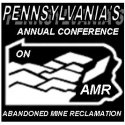A plan for the cleanup and reuse of mining-impacted land and water in the Anthracite Region of Pennsylvania:
Anthracite Remediation Strategy (TR279) – Summary
Full Document
EPCAMR has been using existing borehole water elevations, abandoned mine drainage (AMD) discharge surface elevations, historic mining maps, structural contour geology maps, and geologic cross-sections to recreate the mine pools in a digital 3-D format. We have termed these regional underground mine drainage patterns, Multi-Colliery Hydrologic Units (MCHUs). Our focus area, up until 2011, was on the Western Middle and Southern Anthracite Coal Fields, with the help of a Pennsylvania Department of Environmental Protection (PA DEP) Growing Greener grant.
EPCAMR partnered with the PA DEP Bureau of Abandoned Mine Reclamation (BAMR), Pottsville District Mining Office, and Bureau of Deep Mine Safety, as well as the Dauphin County Conservation District (DCCD), United States Geologic Survey (USGS), and the Pittsburgh Office of Surface Mining (OSM). This partnership was created to develop models of Water Storage Potential or Reservoir Capacity using the current underground dynamic flow patterns, since much of the active pumping of these areas ceased in the 1950s. These mine pools have had over 50 years to fill up and, in some instances, flow out of abandoned mine discharges on the surface.
EPCAMR contracted with the USGS through the DCCD as sponsor to develop a groundwater modeling budget for the Western Middle Coal Field. The USGS estimated mine pool volumes using MODFLOW software and EPCAMR GIS layers, related to barrier pillars, flow paths, tunnels, and the like. Structural contours of the Buck Mountain Vein, the lowest mineable coal seam in the Western Middle Coal Field, were created using USGS Coal Investigation Series reports and maps. The creation of structural contours for the Southern Coal Field posed a problem, due to the absence of structural contour maps for a majority of the field and the complex geology along Sharp Mountain.
In 2010, EPCAMR Staff was trained in the use of a 3-D geologic modeling software called EarthVision, which allows us to create structural contours from geologic cross-sections and visualize these complex underground mine pools. The specialized software also has the ability to estimate remaining coal and mine pool volumes. EPCAMR attempted to create structural contours of the Buck Mountain Vein for the Southern Coal Field, but the software limits the interpretation of beds that dive and rise over ninety degrees. We are working to smooth out the kinks in the software.
There are billions of gallons of water in the abandoned underground mines that are held in the underground mine pools and on the surface in mine water-filled pits. In the Western Middle Coal Field alone, there are 58 underground mine pools containing 38 billion gallons of water. These calculations were made in the 1950s by Stephen Ash and others in a series of U.S. Bureau of Mines reports, when many of the collieries were still actively mining and pumping water. Present day totals are much greater, now that most mining has ceased in the Western Middle and Southern Coal Fields. EPCAMR is trying to update these numbers, given all of the new groundwater and structural geology modeling applications and the growing utilization of Geographic Information System (GIS). Please see the Mine Pool Mapping Initiative page for an update.
On March 11, 2010, EPCAMR and the Susquehanna River Basin Commission (SRBC) held a regional meeting at the Penn State Hazleton Campus to discuss the development of an Anthracite Region AMD Remediation Strategy for the Susquehanna River Basin. It was also a good opportunity for EPCAMR to seek out additional mining maps, references, and borehole or discharge data that would assist in filling in the gaps throughout the four Anthracite coal fields in Pennsylvania. EPCAMR also put forth several proposals to the Northern Bituminous Region to further the development of the Mine Pool Mapping Initiative to map out those areas to see if it can be duplicated statewide.
Future work is planned, in partnership with the SRBC and the Lackawanna River Corridor Association (LRCA), for the lower Lackawanna River watershed, particularly at the Old Forge AMD Borehole and the Scranton-Metro Mine Pool Complex in the Northern Coal Field. EPCAMR has secured funds from the SRBC to work in the Wyoming Valley, Upper Lackawanna, and Southern Coal Field, picking up where we left off with Growing Greener funding. A major portion of the Northern and Southern Coal Fields lie in the Susquehanna River Basin. Additional funding has also been secured to work in the Eastern Middle Coal Field.
The mine pools can be viewed as both a curse and a blessing. Extensive groundwater pollution and thousands of miles of streams, degraded by AMD, are the curse of more than 200 years of Anthracite coal mining. It will take anywhere from 100 to 500 years for all the pyritic material to leach from a given mine. Eventually, the mines will release water that meets water quality standards. The blessing is the potential availability of the billions of gallons of water and high volumes of AMD in the mine pools as resources for present and future use. The metal precipitates, such as Iron oxide and Aluminum oxide, have a potential market, once separated from the water. A cost/benefit analysis can be run on individual mines to determine feasibility and possible profit-potential for private sector investment. General framework concepts related to future economic redevelopment opportunities include mine pool re-use, underground storage, water withdrawal requests, AMD treatment, frac water usage, hydroelectric potential, resource recovery of metals, and fisheries recovery.
Due to complex synclinal folding in the Anthracite Region geology, mine pools are stratified similar to natural lakes. This hypothesis may be important when deciding how to manage water resources in the future. Typically, the mine pools have two layers, “top water” and “bottom water.” The split is caused by shallow groundwater recharge, short-circuiting within the mines. Surface water enters the mine pools through subsidence features, fractures, faults, and the like. The bottom water is usually not well-circulated, due to the its depth, and has sulfate concentrations of several hundred milligrams per liter and relatively high concentrations of acidity and metals. Read more about this in the report below.
Stratification in water quality in inundated anthracite mines, eastern Pennsylvania / by K.J. Ladwig.











